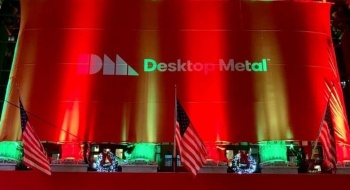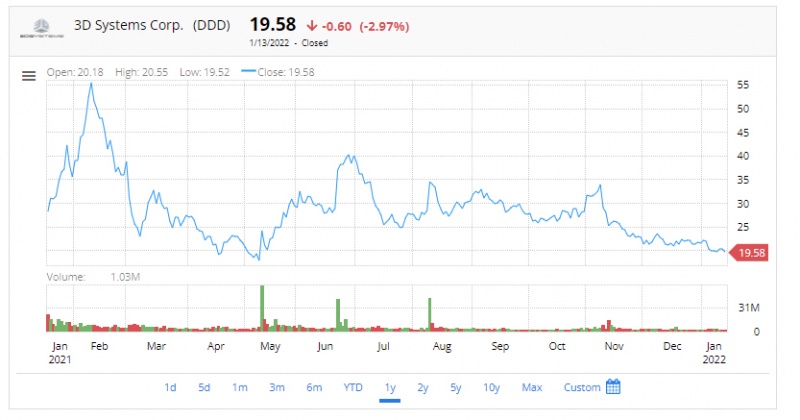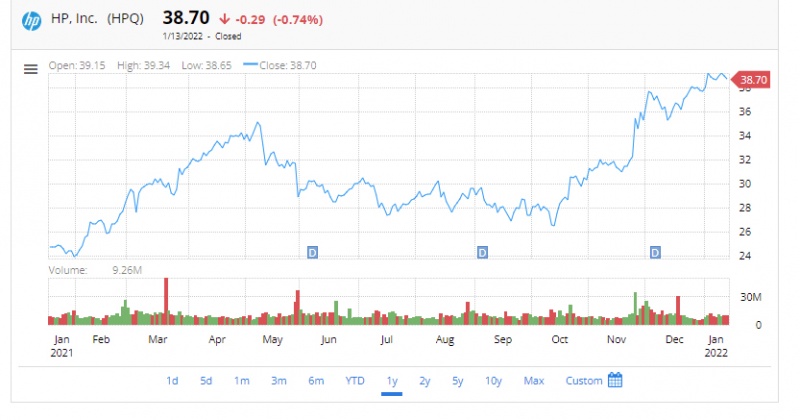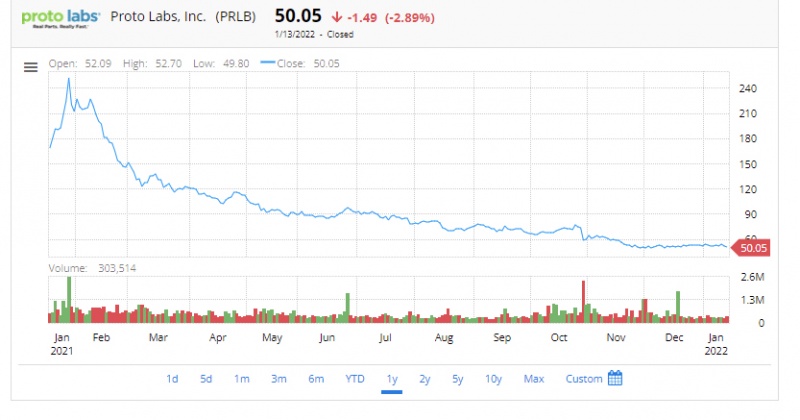
Understanding stock market trends in light of complex AM industry dynamics
Stay up to date with everything that is happening in the wonderful world of AM via our LinkedIn community.
The 3dpbm 3D printing stocks portfolio includes over 50 companies (not all of them can be displayed on the page) that are directly connected to 3D printing technologies, either as core market operators (hardware, services, materials) or as relevant adopters that have made 3D printing a key part of their growth strategy. Based on our continuous coverage of the market, we can help you understand which are the real best and worst 3D printing stocks of 2021 in 3dpbm’s portfolio and, more importantly, what their performance means.
Not all of the companies we track are, of course, pure players (meaning they only operate in the 3D printing market). In fact, for most of these companies, even some of the core market operators, 3D printing today still represents only a minor percentage of their overall business. However, for all these companies AM is considered a key growth area and it shows the company’s will and ability to adapt to — and often dominate — a constantly evolving digital manufacturing world.
Generalist media are not able to track AM companies. They simply don’t understand the industry. Recently we saw a generalist media article listing Organovo as one of “the most innovative 3D printing companies of 2021”, however, Organovo is no longer a 3D printing (or bioprinting) company since January 2020. Even Motley Fool, one of the most capable financial analyst portals, that has been covering the AM industry since before the 2013 stock bubble, is only tracking a handful of companies and thus can only provide very limited insights on best and worst performers.
One thing Motley Fool got right is that 3D Systems is the best performer of 2021 and Desktop Metal is the worst. But the story is a lot more complicated than this. Not to mention that in between these two companies there are more than 25 other 3D printing and 3D printing-related companies worth looking at. Here is the full list. Scroll to the end for comments and insights on some key performers and trends.
Best and worst 3D printing stocks of 2021
- 3D Systems 21.5 US Dollars (+105%) – best AM hardware company
- Jabil 70.3 US Dollars (+66.8%) – best AM service provider
- HPQ 37.7 US Dollars (+56.2%)
- Dassault Systemes Euro 51.3 (+52.3%) – best AM software company
- BLT 213 China Yuan (+35.8%)
- Linde 346.4 US Dollars (+33%) – best AM-related company
- Arkema Euro 125.9 (+33%) – best AM materials company
- Siemens AG 125 Euro (+31%)
- DMG Mori 1977 Japan Yen (+27.9%)
- Stratasys 24.5 US Dollars (+19%)
- Ansys 401 US Dollars (+12%)
- General Electric 94.5 US Dollars (+12.8%)
- BICO 275 Sweden Krona (+9%)
- SLM Solutions 17.3 Euro (+3.8%)
- Carpenter Technology 29 US Dollars (+3%)
- Prodways (6 months) 3 Euro (+3%)
- BASF Euro 62,8 (-3.1%)
- Autodesk 281 US Dollars (-5.3%)
- Renishaw 4,780 UK Pounds (-20%)
- Siemens Energy Euro 22.4 (-22%)
- Velo3D 7.81 Euro (-28.5%)
- voxeljet 5.35 US Dollars (-36%)
- REDWIRE 6.75 US Dollars (-35%)
- Xometry 51.25 US Dollars (-41.3%)
- Markforged 5.4 US Dollars (-50%)
- Nano Dimension 3.8 US Dollars (-55.45%)
- Materialise 23.9 US Dollars (-56.2%)
- Shapeways 3.71 US Dollars (-64%)
- Proto Labs 51.35 US Dollars (-65.8%)
- Desktop Metal 4.95 US Dollars (-69.44%)
Traditional and AM pure players did ok but…
The good news, and a big change from the past, is that most traditional AM pure players did well. It’s a big change after nearly 8 years of declining stock value (since the 2013 bubble). In fact, most of these pure players hit another major peak at the beginning of 2021. Most were not able to keep it up for long but 3D Systems is still up over 100% since the beginning of the year. Stratasys, which is still the current AM market leader is up 20%, while SLM Solutions is up 3.8% (on the Xetra German Index) and Prodways is up 3% (in France).
Out of the traditional pure players (mostly hardware companies), voxeljet continues to struggle (however the low stock price means that the company would make for a great buy if a large group was looking to enter the AM industry). ExOne, on the other hand, no longer exists as a stand-alone stock and is now part of the Desktop Metal Group, which struggled significantly since going public in 2021 (we will see more about this below, in the paragraph dedicated to the many SPAC mergers that took place this year). Another interesting trend to note is that BLT, the leading Chinese public company involved in AM — as a pure player metal 3D printer manufacturer and 3D printing service provider — has grown by a healthy 35% on the Bejing index. Other companies that are very much focused on 3D printing (or bioprinting) and performed well this year include BICO (formerly CELLINK), which grew by another 9% on the Swedish index in 2021 (after a couple of years of continued and rapid growth).

SPACs suffered but…
Yes, with -70% since the IPO (via a SPAC merger), Desktop Metal is the worst performer out of all the 3D printing companies but it seems safe to say that the condition is temporary. In fact all 3D printing companies that went public in 2021 via SPAC mergers dropped between 30% and 70% from their original value (all these operations started from around a $10 stock price).
Companies in a very similar situation to Desktop Metal’s include Shapeways (-64%), Markforged (-50%), REDWIRE (-35%) and Velo3D (-28%), although Velo3D faired better than the other companies in this category. The SPAC merger system to go public is something relatively new. Some early losses are to be taken into account. In addition, most of these companies still represent a somewhat uncertain bet (some more than others): their value is based, at least in part, on their strategic vision and on the expectation that AM will continue to grow at increasingly faster rates. In some cases, it will take time for them to live up to the expectations they have built but we are confident that most of them eventually will.

Relaunch of the giants
Perhaps the best news comes from large companies that are now among the AM market leaders even though 3D printing is still only a very marginal part of their business. 3dpbm’s interpretation is that these companies’ decision to invest significantly in AM has represented and demonstrated an ability to adapt to rapidly changing markets and new challenges. In particular, HP (via HPQ, the part of the company that includes the 3D printing business), is up by 56% since the beginning of 2021. Jabil, a major outsourcing, mass and on-demand production provider, that has invested significantly, in AM is up by 67%.
Even GE, after a very challenging period that led to heavy reorganization, is now up 13%. The major investment that the company made in metal AM (which started with acquiring Concept Laser and Arcam in 2016) has represented a key turning point (even though the benefits took some time to become visible). Renishaw and Siemens Energy are two “giants” that have struggled in 2021 (both down by about -20%) but that is due to external factors. In the case of Renishaw, the company was put up for sale in early 2021 (and the sale process was concluded with no suitable buyer) and restructured its AM business in 2020 to address a new phase of growth; Siemens Energy (which is the part in charge of AM service and AM production activities) was split from Siemens Digital Industries and the rest of the group. In both cases, it may just be taking some time for things to settle.

AM Services struggled but…
Siemens Energy was not the only AM service provider that dropped some stock value in 2021. Two other major AM service providers, until recently shining stars of the AM industry in terms of financial performance, have struggled during this past year, as shown in our best and worst 3D printing stocks of 2021 list. Belgian company Materialise dropped 56% on the Nasdaq, while Proto Labs dropped 65.8%. However, both companies are still up significantly since their IPO and the fact that they grew so much over the past 2-3 years means that they can probably absorb these – still very significant – decreases in stock value. Another leading 3D printing service provider, Shapeways, also dropped 64%, however, this particular case was already discussed above in the section on companies going public via SPAC mergers. Finally, Xometry, an outsourced production services network, filed for a “traditional” IPO this year and still experienced a situation similar to many of the SPAC mergers, with the stock price dropping 41%.

AM software companies stabilizing but…
Leading AM Software companies such as Dassault Systemes, Autodesk, Siemens AG and Ansys have been growing non-stop for years, reaping the benefits of their key role in enabling the digital transition of manufacturing. All these companies are actively involved in the AM industry and figure in this best and worst 3D printing stocks of 2021 list. This year their stock growth has somewhat stabilized, with rates ranging from +56% for Dassault and +31% for Siemens AG to +12% for Ansys and -5.3% for Autodesk (Materialise, also a major 3D software company, is down 56% but this particular case was already discussed in the above section on AM services). Another software-related company that has made some investments in 3D printing and has grown explosively is NVIDIA (not listed above as its adoption of 3D printing remains marginal), growing by 125%.
Disclaimer: Please note that this article is for informational purposes only. The authors of this article own stocks in some of the companies discussed in this article. This article is not intended as an expert recommendation to buy or to sell stocks.
Avtor: Davide Sher


